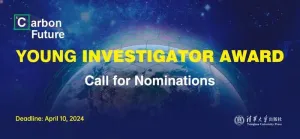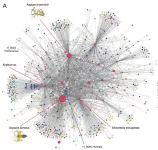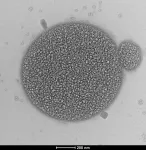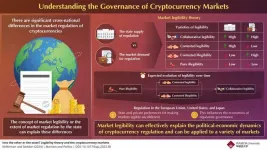Dive into the future of molecular life sciences at #DiscoverBMB 2024
Press passes available for the American Society for Biochemistry and Molecular Biology annual meeting March 23–26 in San Antonio
2024-03-05
(Press-News.org) Which natural products are helping solve biotech challenges? How can enzymes supercharge biodegradation for a greener tomorrow? What role does RNA play in cancer and other diseases? You’ll find the answers to these questions and more at Discover BMB, the annual meeting of the American Society for Biochemistry and Molecular Biology, to be held March 23–26 in San Antonio.
Secure your front-row seat to cutting-edge findings, approaches and technologies in the biological sciences by registering for a complimentary press pass to attend in person or to access press materials electronically. Please note that only a limited number of complementary on-site press passes will be issued, so advance registration is recommended.
This year’s #DiscoverBMB program includes top experts unveiling groundbreaking discoveries and revolutionary approaches in biochemistry and molecular biology. Hot topics include:
Advances in natural product biochemistry and biotechnology
Name any biotechnology challenge and there’s a decent chance that Mother Nature already came up with a solution literally a billion years ago. Living organisms have a knack for producing useful molecules, and there’s a lot we can learn from them to speed up chemical reactions, find new drugs and produce chemical products sustainably. A plethora of discoveries in natural products from genomes, microbiomes and animals will be shared at this symposium. View the speakers
RNA biology
RNA is at the heart of some of the trendiest recent developments such as COVID-19 vaccines and CRISPR — and it’s only just getting started. Get up to speed on the science behind the headlines and find out why RNA is considered one of the most promising drug targets and platforms at this stimulating symposium. We’ll trace the RNA life cycle, probe how it’s translated into protein and find out how RNA regulation factors into neurodegenerative diseases and cancer. View the speakers
Cool and novel enzymes
Enzymes know how to make things happen! Find out how scientists are putting them to work in this symposium highlighting new discoveries about enzyme functions, mechanisms and applications. Meet enzymes that manage misbehaving metabolites and explore how they can be used to catalyze novel reactions, boost biodegradation and synthesize chemicals currently produced from petrochemicals. View the speakers
Signaling mechanisms in the nucleus
The nucleus has long been revered as the control center of eukaryotic cells. But what exactly regulates the intricacies of what goes on in there, what happens when things go awry and how could new therapeutic approaches help right the ship? This symposium will focus a new lens on longstanding questions about organism development, cellular identity and the genetic basis for disease. View the speakers
Microbial signaling, communication and metabolism
This symposium will catch you up on the latest microbial gossip as we listen in on the small-molecule signals bacteria use to communicate with each other, decipher how microbial machines coordinate massively complex regulatory and responsive strategies, and untangle the vast webs of interactions and intrigue within members of microbial communities. View the speakers
Follow #DiscoverBMB on Facebook, X, Instagram and LinkedIn.
Contact:
Anne Johnson
(571) 271-1986 (mobile)
media@asbmb.org
About the American Society for Biochemistry and Molecular Biology (ASBMB)
The ASBMB is a nonprofit scientific and educational organization with more than 12,000 members worldwide. Founded in 1906 to advance the science of biochemistry and molecular biology, the society publishes three peer-reviewed journals, advocates for funding of basic research and education, supports science education at all levels, and promotes the diversity of individuals entering the scientific workforce. www.asbmb.org
Questions? Contact us at media@asbmb.org
END
ELSE PRESS RELEASES FROM THIS DATE:
2024-03-05
The Network for Education and Research on Peace and Sustainability (NERPS) at Hiroshima University is inviting submissions for Trends in Peace and Sustainability (TRENDS), an innovative academic platform dedicated to exploring the complex interplay between peace and sustainability. TRENDS aims to become a forum for scholars, professionals, and advocates to share their research, insights, and viewpoints on the pursuit of peace amid sustainability challenges. It aims to promote interdisciplinary engagement, stimulating conversation ...
2024-03-05
The call for the 2024 Carbon Future Young Investigator Award is open!
About The Award
Tsinghua University Press announces the 2024 Carbon Future Young Investigator Award. This award is intended to recognize and encourage outstanding early career researchers in the areas of carbon-related materials, catalysis, energy conversion and storage, as well as low carbon emission process and engineering. The award includes an honorarium of $1,000 for each awardee (up to 10 awardees).
Eligibility
The nominee must be a current PhD student or postdoctoral researcher.
The nominee’s ...
2024-03-05
ST. LOUIS, MO, March 5, 2024 – The Donald Danforth Plant Science Center and the Ethiopian Institute of Agricultural Research (EIAR) have received a $4.9 million grant from The Bill & Melinda Gates Foundation to build on previous advances in gene editing of tef for reduced height and lodging resistance in advanced, farmer preferred tef lines.
The grant will support research to validate the improved semi dwarf tef in Ethiopia under greenhouse and multi location field conditions and generate lodging resistance ...
2024-03-05
In a series of studies, a team of astronomers has shed new light on the fascinating and complex process of planet formation. The stunning images, captured using the European Southern Observatory's Very Large Telescope (ESO’s VLT) in Chile, represent one of the largest ever surveys of planet-forming discs. The research brings together observations of more than 80 young stars that might have planets forming around them, providing astronomers with a wealth of data and unique insights into how planets arise in different regions of our galaxy.
“This is really a shift in our field of study,” says Christian Ginski, a lecturer at the University of Galway, Ireland, ...
2024-03-05
A theoretical experiment characterized the network architecture of a species-rich ecosystem over 8 months. Predator–prey interaction networks play a key role in structuring ecosystems, but ecological research has often treated such networks as static, despite the broadly accepted understanding of ecosystems as dynamic. Hirokazu Toju and colleagues followed the complex food webs between 50 predatory spider species and 974 prey species, including midges, springtails, mosquitoes, and aphids, for eight months. The studied ecosystem is a warm-temperate grassland ...
2024-03-05
In the Japanese art of Kintsugi, an artist takes the broken shards of a bowl and fuses them back together with gold to make a final product more beautiful than the original.
That idea is inspiring a new approach to managing plasma, the super-hot state of matter, for use as a power source. Scientists are using the imperfections in magnetic fields that confine a reaction to improve and enhance the plasma in an approach outlined in a new paper in the journal Nature Communications.
“This approach allows you to maintain ...
2024-03-05
Researchers built a model that can predict with 73.5% accuracy when a person will experience aesthetic chills: shivers, goosebumps, or a feeling of cold down the neck or spine elicited by aesthetic stimuli, such as beautiful music or an inspirational speech. Felix Schoeller and colleagues surveyed 2,937 people from Southern California, through an online platform, gathering data on their personalities, demographic backgrounds, and emotional state. The authors then exposed survey respondents to 40 emotion-evoking audiovisual clips sourced from social media, selected because commenters had reported experiencing aesthetic chills while watching and listening. ...
2024-03-05
PULLMAN, Wash. – Bacteria can be tricked into sending death signals to stop the growth of their slimy, protective homes that lead to deadly infections, a new study demonstrates.
The discovery by Washington State University researchers could someday be harnessed as an alternative to antibiotics for treating difficult infections. Reporting in the journal, Biofilm, the researchers used the messengers, which they named death extracellular vesicles (D-EVs), to reduce growth of the bacterial communities by up to 99.99% in laboratory experiments.
“Adding the death extracellular vesicles to ...
2024-03-05
Text-to-image generative AI systems like Midjourney, Stable Diffusion, and DALL-E can produce images based on text prompts that, had they been produced by humans, would plausibly be judged as “creative.” Some artists have argued that these programs are a threat to human creativity. If AI comes to be relied on to produce most new visual works, drawing on what has been done before, creative progress could stagnate. Eric Zhou and Dokyun “DK” Lee investigated the impact of text-to-image AI tools on human creativity, seeking to understand ...
2024-03-05
Since its introduction, cryptocurrency governance has been one of the most controversial global financial topics. While some countries have established elaborate regulations for cryptocurrencies, many countries are still reluctant to oversee the markets, and some have outright banned them. Most studies suggest that public agencies naturally want to regulate markets and bring them into their purview. However, the significant differences in cryptocurrency regulation over the world call this view into question. Moreover, these differences cannot be explained by the development ...
LAST 30 PRESS RELEASES:
[Press-News.org] Dive into the future of molecular life sciences at #DiscoverBMB 2024
Press passes available for the American Society for Biochemistry and Molecular Biology annual meeting March 23–26 in San Antonio




